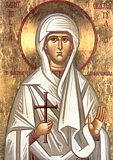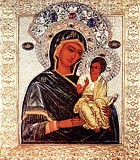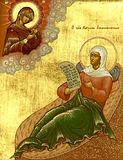

| Previous day | Next day |
| Old Style
July 16
|
Wednesday |
New Style
July 29
|
|
8th Week after Pentecost.
Tone 6.
Fast Day. |
Wine and oil allowed.
|
![]() Hieromartyr Athenogenes, bishop of Heracleopolis, and his ten disciples (ca. 311).
Hieromartyr Athenogenes, bishop of Heracleopolis, and his ten disciples (ca. 311).
Martyrs Paul and two sisters, Chionia (Thea) and Alevtina (Valentina), at Caesarea in Palestine (308). Martyr Antiochus, physician, of Sebaste (4th c.). Commemoration of the Fourth Ecumenical Council (451). Virgin-martyr Julia of Carthage, at Corsica (440). St. Theodotus, monk of Glinsk Hermitage (1859). St. Magdalena, schema-abbess of New Tikhvin Convent in Siberia (1934). Synaxis of Russian Saints glorified at the Moscow Councils of 1547 and 1549.
New Confessor Matrona Belyakova, fool-for-Christ, of Anemnyasevo (1936). New Hieromartyrs James (Maskaev), archbishop of Barnaul, and priests Peter and John, and with them Monk-martyr Theodore (Nikitin) and Martyr John (1937). New Hieromartyr Ardalion (Ponamarev), archimandrite, of Kasli (Chelyabinsk) (1938).
Icon of the Mother of God of Chirsk-Pskov (1420).
Martyr Helier of Jersey (6th c.). St. John of Vishnya and Mt. Athos, activist against Uniatism (c. 1630). New Martyr John of Turnovo (1822). 15,000 Martyrs of Pisidia.
Thoughts for Each Day of the Year
According to the Daily Church Readings from the Word of God
By St. Theophan the Recluse

Wednesday. [I. Cor. 10:12-22; Matt. 16:20-24]
When the Holy Apostles confessed the Saviour to be the Son of God, He said, I must…suffer…and be killed. The work had ripened; it remained only to complete it through the death on the cross. The same thing occurs in the course of a Christian’s moral progress. While he is struggling with his passions, the enemy still hopes somehow to tempt him; but when passions have settled down and the enemy no longer has enough power to awaken them, he presents external temptations, all sorts of wrongful accusations, moreover, the most sensitive. He tries to plant the thought: “So what did you work and struggle for? No good will come of it for you.” But when the enemy thus prepares a war from without, the Lord sends down the spirit of patience to his struggler, thereby preparing a lively readiness in his heart for all sorts of suffering and hostility before the enemy can manage to stir up trouble. As the Lord said about Himself, I must suffer, spiritual strugglers also feel a sort of thirst for sorrows. And when the suffering and hostility come, they meet them with joy, and drink them in like a thirsting man drinks cooling water.
Articles
 Martyr Antiochus the Physician of SebasteThe Holy Martyr Antiochus, a native of Cappadocian Sebastea, was the brother of the holy Martyr Platon (November 18), and he was a physician. |







